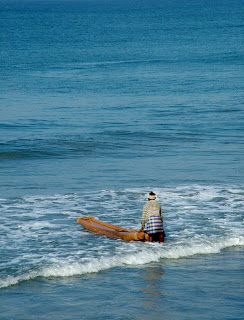This article was first published in the TRINet blog, part of the TRINet October 2011 Newsletter.
 |
| Photo: The Hindu |
The anti-nuclear movement against the Koodankulam project began less than a month after India and the Soviet Union signed the deal on 20 November 1988. In 1989, during a demonstration in Kanyakumari by over a thousand people, organised by the National Fishworkers Union, the police opened fire and disabled the public address system. This angered the demonstrators further and many more meetings and protest marches were organised in the aftermath but it was the collapse of the Soviet Union that literally sunk the project into hibernation.
In 1998, the project was revived and in 2001, Dr.SP Udayakumar from Nagercoil founded a broad umbrella organization, People’s Movement Against Nuclear Energy (PMANE) with a focus on public education. They organised meetings, seminars and street gatherings among students, concerned citizens, associations of women, farmers, students, teachers, fishermen and religious leaders. Most of the people in the three southern districts of Kanyakumari, Tirunelveli and Thoothukudi were sensitized of the dangers posed by the Koodankulam project.
When the first two phases of the project (Koodankulam 1 & 2) were finalised there were no mandatory provisions for an environment impact assessment and neither any windows for hearing people’s opinions for or against the project. The earliest official opportunity for local communities came in October 2006 and the administration was overwhelmed by hundreds of people who registered forcing it to abort the hearing.
Since then, the administration has relentlessly tried to suppress the agitating crowds failing completely to understand their concerns. Activists were targeted – they began receiving phone calls from the police and the Intelligence Bureau. Some were even taken into custody on false charges.
The unwillingness of the administration to heed to the concerns of local communities was even seen in the most recent of these ‘hearings’. The EIA document circulated was in English, incomprehensible to local communities, and was found to be flawed in many places.
This year, when plans to commission the project were announced, the People’s Movement Against Nuclear Energy (PMAE) spearheaded an agitation involving 127 villagers including 20 women, 4 physically challenged and 7 members of the Catholic clergy who went on an indefinite fast from 11 September 2011.
At first, the administration tried to suppress the agitation but the overwhelming support of local communities, their elected representatives and the long shadow of the Anna Hazare campaign made them reconsider their strategy. The PM, Manmohan Singh sent an emissary, V Narayanasamy, but the agitating members of the community refused to meet him. The CM of Tamil Nadu, J Jayalalita defused the situation by persuading the PMANE to suspend the agitation for three months to give the Centre time to address the people’s concerns. The settlement terms gave the authorities time to consider the issues, and the protesters were free to resume the agitation if their expectations were not fulfilled.
The scientific community, meanwhile, has been batting for the project saying the plant had features such as better seismic and tsunami resistance and could withstand a Fukushima-like accident and others.
Talking to the press, Srinivasan, also a former Director, Projects, Nuclear Power Corporation of India (NPCIL), said, world over, countries such as China and Iran besides India India
BRP Bhaskar, a political analyst of reckoning, writing in the Gulf Today, says, at current costs, generation of additional 15,000MW of nuclear power will involve an investment of no less than Rs.3,000 billion. It makes no sense to make an investment of that order on plants that are to be abandoned after three decades. It will be prudent to divert the money for development of alternative energy sources straightaway.
It has become increasingly clear that our elected representatives, the bureaucracy and scientific community have stopped listening to the very communities they are accountable to. Long term vision and impact on humans is on the back burner and the focus has now narrowed to their terms in office.
“I am increasingly getting concerned about the "short term ownership/ caretaker" mentality of the so-called elected representatives of the people and the attitude of bureaucrats who pander to those in power, the govt staff and academia who are only bothered about anything adversely affecting their lifelong pensions,” says Annie George, CEO, Bedroc, an NGO based in Nagapattinam. “So who is the final owner? Who holds the commitment to long term issues and long term development,” she asks.
The rising stock market and a relatively stable economy is pushing the government to compromise on the environment. The environment and local communities have never before been so much threatened by wanton development. The POSCO project where a well established agrarian economy is being destroyed to accommodate a steel plant, is another example of such violations spearheaded by the government. Defending humanity seems to be the last thing on their minds. The onus of protecting the environment now seems to be upon the people more than the administrators, and this is indeed a matter of grave concern that needs to be addressed urgently.



